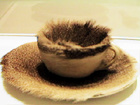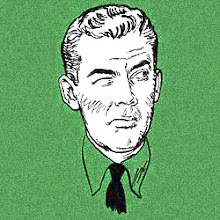 Late in ’59, Eleanor Ruggles’ biography of Vachel Lindsay was published and there was briefly a revival of interest – most of it doubtful – in Lindsay as a chanting performing poet. Two other biographical books had been published, a first by Edgar Lee Masters in 1935, a second in ’52, a fictionalized biography, by a then-young Mark Harris.
Late in ’59, Eleanor Ruggles’ biography of Vachel Lindsay was published and there was briefly a revival of interest – most of it doubtful – in Lindsay as a chanting performing poet. Two other biographical books had been published, a first by Edgar Lee Masters in 1935, a second in ’52, a fictionalized biography, by a then-young Mark Harris.This new book brought out Kenneth Rexroth and Granville Hicks, veterans by then of the political-poetry wars. Rexroth had not much good to say about where Lindsay fit: naively American, a dreamer of the (false) American Dream. Today, Rexroth guessed, Lindsay would be a “mildly rightish liberal, a common-sense New Dealer,” essentially a patriotic Midwestern populist, “hopelessly naïve.” The poetry had been “not very good.”
For Hicks, Lindsay stood against – or ran differently from or parallel to – modern poetry. “He was enthusiastic and hopeful; the moderns are secretive and dark.” Yet Harriet Monroe published him in 1913, and Yeats deemed him “the great native American genius.” When Monroe printed VL’s poem about the Salvation Army’s General Booth (“General Booth Enters into Heaven”) in Poetry she made sure to include the parenthetical instructions for bass drum, banjo, flute, etc., that made it a poem with a difference: one meant to be chanted, sung, performed.
In ’59 he was “eccentric and faintly embarrassing.” He’d literally walked around the Northwest in the first years of the 20th century, provisioned with a pack of poems and no money. He traded poems and talk for food, and announced to astonished citizens of small towns in Oregon and Washington State that “I am the sole active member of the ancient brotherhood of the troubadours.” In the non-Poundian sense of the term, he might have been right at that moment.
Lindsay made performance poetry – poetry printed as a score for chanted performance – something Rotary Clubs and high-school assembly attendees knew as part of the modern American poetic landscape. It’s NOT that – as Time mag put it in its November 23, 1959 issue – Vachel Lindsay was out of date and that “chanting about the heartland seemed naïve to readers caught by the puzzles of The Waste Land.” No. The trick would be whether we could ever – in light of these dismissals at the end of the 50s – see that the Eliotic collaged dramatic monologues and snatches of ritual on the one hand and the boomlay-booming scored chants of another Midwesterner were actually part of the same movement.
The Vachel Lindsay PennSound page has a few crucial recordings, including "The Congo" and one of my favorites, "The Mysterious Cat."
sources: Rexroth in The Nation, Nov 28, 1959, p. 404; Hicks in Saturday Review Nov 21, 1959, p. 39. Ruggles’ bio is called The West-Going Heart (Norton).

 Is '60 the moment when the end of the end of the Old Left had been reached and the New Left began to emerge? Is it the final ascendancy, in certain scenes at least, of poetic postmodernity? Surely the publication of Donald Allen's The New American Poetry that year suggests this, but then again--once again--we look back on "New" here and see continuity. The rhetoric of the Kennedy-Nixon contest made much less of a dent than everyone (at the time as well as since) claimed, so one wonders why were such great claims made?
Is '60 the moment when the end of the end of the Old Left had been reached and the New Left began to emerge? Is it the final ascendancy, in certain scenes at least, of poetic postmodernity? Surely the publication of Donald Allen's The New American Poetry that year suggests this, but then again--once again--we look back on "New" here and see continuity. The rhetoric of the Kennedy-Nixon contest made much less of a dent than everyone (at the time as well as since) claimed, so one wonders why were such great claims made?  Had we come to expect "1960" to be truly ubiquitously modern in a way that the 1950s really were not--not quite? And what specifically does "modern" mean in the Kennedyesque talk then and now about the torch being passed to a new generation, etc.? The First Lady really meant "modernist" when Camelotians said "modern." What about the others across the new young cultural leadership? I've been surprised by how frequently the
Had we come to expect "1960" to be truly ubiquitously modern in a way that the 1950s really were not--not quite? And what specifically does "modern" mean in the Kennedyesque talk then and now about the torch being passed to a new generation, etc.? The First Lady really meant "modernist" when Camelotians said "modern." What about the others across the new young cultural leadership? I've been surprised by how frequently the  "Beat movement" was covered in 1960 in the mainstream press. I was expecting a fair measure but I've found tonnage. 1960 was the year when the figure of the beat was beginning to find acceptance, although still 80% of these stories are mocking, rebels-without-cause condescension. For anyone whose analysis made an impact nationally, do these antipolitical adolescents count as part of the "new young cultural leadership"? No, but rather than the two being opposites, they fall along a Continuum of the New American. Now that's a change for '60.
"Beat movement" was covered in 1960 in the mainstream press. I was expecting a fair measure but I've found tonnage. 1960 was the year when the figure of the beat was beginning to find acceptance, although still 80% of these stories are mocking, rebels-without-cause condescension. For anyone whose analysis made an impact nationally, do these antipolitical adolescents count as part of the "new young cultural leadership"? No, but rather than the two being opposites, they fall along a Continuum of the New American. Now that's a change for '60.







